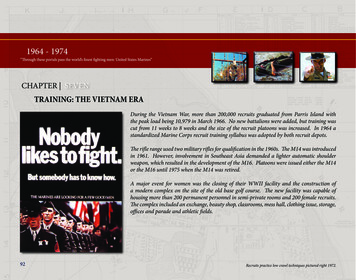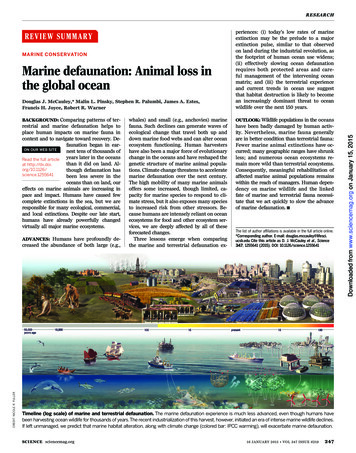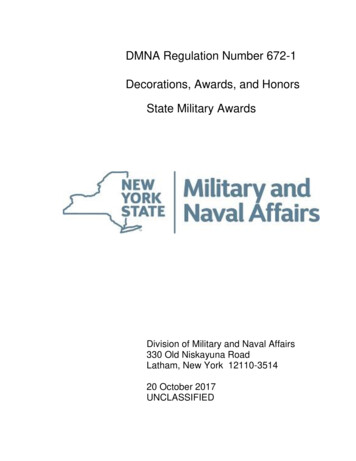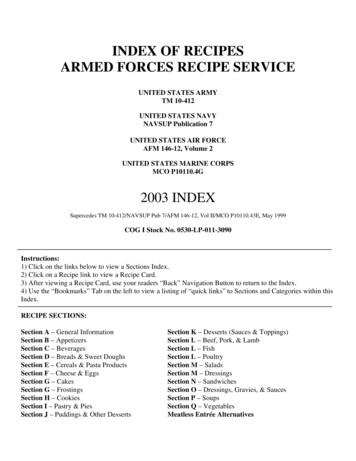
Transcription
1964 - 1974“Through these portals pass the world’s finest fighting men: United States Marines”CHAPTER SEVENTRAINING: THE VIETNAM ERADuring the Vietnam War, more than 200,000 recruits graduated from Parris Island withthe peak load being 10,979 in March 1966. No new battalions were added, but training wascut from 11 weeks to 8 weeks and the size of the recruit platoons was increased. In 1964 astandardized Marine Corps recruit training syllabus was adopted by both recruit depots.The rifle range used two military rifles for qualification in the 1960s. The M14 was introducedin 1961. However, involvement in Southeast Asia demanded a lighter automatic shoulderweapon, which resulted in the development of the M16. Platoons were issued either the M14or the M16 until 1975 when the M14 was retired.A major event for women was the closing of their WWII facility and the construction ofa modern complex on the site of the old base golf course. The new facility was capable ofhousing more than 200 permanent personnel in semi-private rooms and 200 female recruits.The complex included an exchange, beauty shop, classrooms, mess hall, clothing issue, storage,offices and parade and athletic fields.92Recruits practice low crawl techniques pictured right 1972.
Physical fitness remained apriority and included sit-ups,pull-ups, push-ups, bends andthrusts and a 300-yard shuttlerun. Recruits also engaged inteam building exercises suchas the obstacle and confidencecourses, log drills, rope climbing,body carrying, and tug of war.Female recruits were also nowrequired to receive swim training,gas mask instruction (picturedhere) and standardized cosmeticapplication classes.In 1971 a formalized IndividualCombat Training (ICT) wasadded to the recruit’s curriculum.From 1971 to 1973 recruitsand their drill instructors werebused to Camp Lejeune for oneto two weeks of field training.By 1974 facilities for ICT werecompleted at Page Field andthe trips to Camp Lejeune werediscontinued.PARRISISLAND-VIETNAM1965Arriving in force, Marines serveprimarily in South Vietnam’s fiveNorthern provinces known asMilitary Region I, or “Eye Corps.”1965In January, recruit receiving movesfrom H&S Battalion to a new locationnear regimental headquarters. At thistime the famous yellow footprints firstappear.
Female swim qualification circa, 1970Obstacle course, circa 19721965Yemasee Train station closes;recruits now arrive fromCharleston, SC.1965Women Marines Recruit TrainingBattalion graduates first DualPlatoons; Platoon 8-A and 8-BMarksmanship training, circa 19721971A formalized IndividualCombat Training (ICT) atCamp Lejeune is added tothe recruit’s curriculum.1974Facilities for ICT arecompleted at Page Fieldand the trips to CampLejeune are discontinued.
circa 1970Drill Instructor circa 1970Field Training 197496Graduationcirca 1970
Marine recruits learning landmine sweeping and disarming techniquesunder drill instructor supervision, circa 1970.
Marine recruits getting their medical evaluations upon arrival to Parris Island, circa 1964.
Individual Combat TrainingGeneralized combat training has been taught at Parris Island since it first opened its gates as arecruit depot in 1915. However the main focus of the training was put on basic Marine skills,drill and marksmanship. Specialized field training was reserved primarily for those chosen toserve directly in combat arms or the infantry field.In 1971, a formalized Individual Combat Training (ICT) was added to the recruit’s curriculum.Recruits began to learn bivouacking, water and field sanitation, land navigation, camouflage, coverand concealment, basic patrolling and tactical formations, combat hand and arm signals and basicenvironmental survival techniques aimed at creating a basic rifleman.Between 1971 to 1973 recruits and their drill instructors were bused to Camp Lejeune (pictured right)for one to two weeks of field training since Parris Island did not have the facilities and required rangesin place to facilitate the field training events required for graduation. By 1974, facilities for ICT werecompleted at Page Field and the trips to Camp Lejeune were discontinued.In the spring of 1988, the Individual CombatTraining phase of recruit training was expandedand renamed ‘Basic Warrior Training’ (BWT).BWT aimed to expose recruits to combattraining so that all Marines, no matter whattheir military occupational specialty, couldserve effectively as a basic rifleman.Currently, BWT is instructed by the Weaponsand Field Training Battalion, occurring duringweek nine of the recruit training schedule.The current curriculum consists of previouslytaught basic field skills to include combathunter, improvised explosive device detection,interior guard and individual, buddy and fireteam movements.Amphibious assault training. circa 1975.
standardized Marine Corps recruit training syllabus was adopted by both recruit depots. The rifle range used two military rifles for qualification in the 1960s. The M14 was introduced in 1961. However, involvement in Southeast Asia demanded a lighter automatic shoul










